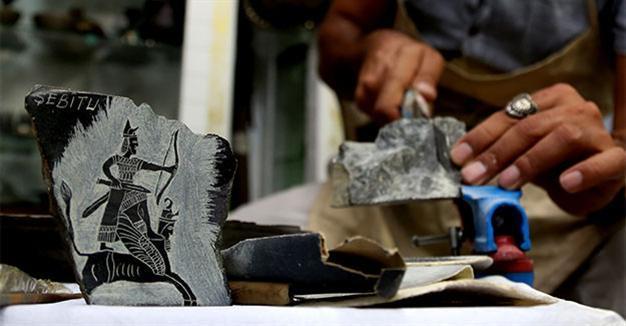Urartian motifs on jewelry
VAN – Anadolu Agency

AA photo
Drawings on inscriptions and stones from the Urartian kingdom, which ruled in the region in the 8th century B.C., are being used by artists in the eastern province of Van. The drawings are engraved on jewelry and stones.
The Urartian kingdom, which reigned in the Eastern Anatolian region between 900-600 B.C., is known for their skills in architecture, mining, rock carving, embossing and stonemasonry.
Artists in Van were inspired by the Urartian artifacts unearthed during excavations in the city, such as 3,000-year-old earrings, necklaces, rings, brooches, belts and inscriptions.
One of these artists, Ferhat Şimşek, has been engraving Urartian figures on jewelry for 10 years. He uses various decorating techniques such as coating, embossing, buckling, filigree and granulation that were used by the Urartians some 3,000 years ago.
Stating that he had been researching historical artifacts around Van for many years, Şimşek said his interest in stones and the lifestyle of civilizations that settled in the region had started during this research.
“Thanks to this interest, I started searching old civilizations. The engravings on old stones drew my attention. People who lived thousands of years ago left many artifacts. Then I decided to deal with this art 10 years ago. During my studies in Van’s Tırişin Tableland, I saw many stone artifacts with hand-made engravings. Locals also told me that there were cigarette holders in a place nearby and I went there to take some stones. Then using these stones, I imitated the artifacts from the Hurri-Mitani civilization, which lived there 3,000 years ago, and succeeded in reaching people who are interested in these things,” he said.
Hobby becomes means of living
Speaking of the difficulty of this work, Şimşek said, “I cannot say that I completely learned the Urartian language because it is not a living language but a lost one,” and continued:
“Archaeologists from the Yüzüncü Yıl University and Mehmet Kuşman, who speaks Urartian, paved the way for us. The Urartians who ruled in the region for 400 years may not mean anything for people but historians know that they were very developed in handicrafts, domestication, sewage, construction of water channels and transition to irrigated farming. I am not very good at reading the inscriptions but I am a good artist with skills in engraving.”
He said it was a hobby for him at first but then turned into means of living.
“Now I think that I play a significant role in shedding light on an ancient civilization. I have been studying Middle Eastern languages and culture at the British Museum and a university in London for eight months,” he said.
The art of engraving on stone had been initiated by the Hittites and then maintained by the Urartians, Şimşek said, adding, “Stone is long lasting; this is why it is in demand. It can survive up to 20,000 years if it is not affected by external factors.”
He said he received orders from Turkey and abroad, adding that he had recently gifted a stone plaque with Urartian writing to the mayor of Haringey in England.
